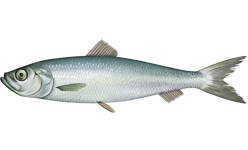
Alosa is a genus of fish, the river herrings, in the family Alosidae. Along with other genera in the subfamily Alosinae, they are generally known as shads. They are distinct from other herrings by having a deeper body and spawning in rivers. Several species can be found on both sides of the Atlantic Ocean and the Mediterranean Sea. Also, several taxa occur in the brackish-water Caspian Sea and the Black Sea basin. Many are found in fresh water during spawning and some are only found in landlocked fresh water.

The allis shad is a widespread Northeast Atlantic species of fish in the Alosidae family. It is an anadromous fish which migrates into fresh water to spawn. It is found in the eastern Atlantic Ocean, the western Baltic Sea and the western Mediterranean Sea. In appearance it resembles an Atlantic herring but has a distinctive dark spot behind the gill cover and sometimes a row of up to six spots behind this. It sometimes hybridises with the twait shad. This fish becomes mature when three or more years old and migrates to estuaries, later swimming up rivers to spawn. Populations of this fish have declined due to overfishing, pollution and habitat destruction. Conservation of this species is covered by Appendix III of the Bern Convention and Appendix II and V of the European Community Habitats Directive.

The twait shad or twaite shad is a species of fish in the family Alosidae. It is found in the eastern Atlantic Ocean and the Mediterranean Sea and is an anadromous fish which lives in the sea but migrates into fresh water to spawn. In appearance it resembles an Atlantic herring but has a row of six to ten distinctive spots on its silvery flanks. They become mature when three or more years old and migrate to estuaries, later swimming up rivers to spawn. Populations of this fish have declined due to overfishing, pollution and habitat destruction. Conservation of this species is covered by Appendix III of the Bern Convention and Appendix II and V of the European Community Habitats Directive.

Alosa maeotica, known as the Black Sea shad or Azov shad, is a species of Alosid fish endemic to the Sea of Azov and the western part of the Black Sea basin. It is found in Bulgaria, Georgia, Moldova, Romania, Russia, Turkey, and Ukraine.
Alosa vistonica the Thracian shad, is a species of shad, a freshwater fish in the family Alosidae. It is endemic to a single shallow lake, Lake Vistonida in Greece. It is classified as critically endangered (CR) and is threatened by sewage, industrial effluents, destruction of spawning sites by agricultural development and increased salinity following the opening of a canal into the sea. It has been suspected to be extinct already.

Alosa caspia is a species of [[alosid]] fish, one of the species of shad endemic to the Caspian Sea basin.
Alosa algeriensis, the North African shad, is a Mediterranean species of clupeid fish in the shad genus Alosa.

Alosa braschnikowi, the Caspian marine shad or Brazhnikov's shad, is one of the alosid fish species endemic to the Caspian Sea.

The Pontic shad, also referred to as the Black Sea shad or Kerch shad, is a species of clupeid fish in the genus Alosa, native to the Black Sea and Sea of Azov basins.
Alosa kessleri, also referred to as the Caspian anadromous shad, the blackback, or the black-spined herring, is a species of alosid fish. It is one of the several species of shad endemic to the Caspian Sea basin.
The Killarney shad, also called the goureen, is a freshwater fish in the family Alosidae, endemic to a single lake in Ireland, Lough Leane in County Kerry. Research has shown that it is a landlocked subspecies of the anadromous, twait shad, arriving in the lake after the Last Glacial Maximum about 10,000 years ago. This fish is at risk from eutrophication and the introduction of alien species of fish to the lake and the International Union for Conservation of Nature has rated it as "critically endangered".
Alosa saposchnikowii, or the saposhnikovi shad, is a species of fish in the clupeid genus Alosa. It is one of the endemic species of this genus in the Caspian Sea area.
Alosa sphaerocephala, or the Agrakhan shad, is a species of alosid (herring-like) fish, one of the endemic shad species in the Caspian Sea.
Alosa volgensis, the Volga shad, is a alosid fish, one of the species of shad endemic to the Caspian Sea region.
Black Sea shad is a common name for several fish in the genus Alosa which occur in the Black Sea and may refer to:

Azov percarina is a species of ray-finned fish in the family Percidae.

Clupea is genus of planktivorous bony fish belonging to the family Clupeidae, commonly known as herrings. They are found in the shallow, temperate waters of the North Pacific and the North Atlantic oceans, including the Baltic Sea. Two main species of Clupea are currently recognized: the Atlantic herring and the Pacific herring, which have each been divided into subspecies. Herrings are forage fish moving in vast schools, coming in spring to the shores of Europe and America, where they form important commercial fisheries.
Azov shad is a common name for several fishes and may refer to:

The Alosidae, or the shads, are a family of clupeiform fishes. The family currently comprises four genera worldwide, and about 34 species.
Alosa curensis, the Kura shad, is one of the species of alosid fish endemic to the Caspian Sea basin. It is found in the southwestern part of the brackish sea-lake, near the mouth of the Kura River, Azerbaijan. But generally this is a poorly known species.









